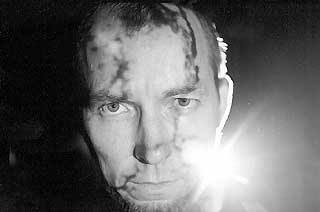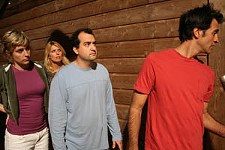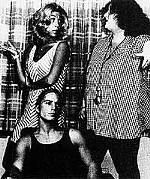Projecting an Image
The Mind-Bending Film Art of Luke Savisky
By Bryan Poyser, Fri., June 16, 2000

This is how I know Luke. It was December 1997, the last day of operation for the Texas Union Film Program (Does anybody still remember it now?), and a group of UT Radio-Television-Film students were staging a protest outside the theatre, mourning the program's passing with screams and banging pots instead of mute acceptance. I had heard that Luke Savisky would do one of his projection things outside the theatre, and when I saw a towering blond-haired guy unloading what seemed like an endless supply of 16mm and 8mm projectors out onto the sidewalk, I knew it was him. While the protest raged on, I kept checking on Luke and his impromptu tower of spinning reels and jerking strips of film. What he finally created was a film-of-many-films, a butterfly-shaped multiscreen of magenta-tinged found footage and handmade and camera-made abstractions that I can only describe as a collage that moved. I took a walk around the Union in a moony, apocalyptic state of mind, fantasizing about the entire building covered with cinema, images projected on every willing or unwilling surface. Cinema had expanded.
Luke Savisky has been doing this to people for well over 15 years. He has augmented the work of artists of all stripes with his massive collection of film projectors and stretched the mental dimensions of cinema with his own multimedia performances. He appeared in Slacker; he has toured with the bands Poi Dog Pondering, Ed Hall, Stars of the Lid, Mercury Rev, and Sixteen Deluxe using slides and film loops as a counterpoint to the music; he has done installations for choreographers, dance troupes, theatre groups, and arts festivals like the Cinematexas Short Film Festival, FronteraFest, and Fringefest. On Wednesday, June 21, he will present the fourth in his own series of "Film Actions" at the Alamo Drafthouse Theatre, a collaboration with the Golden Arm Trio and the Tosca String Quartet. Film Actions I through III, collaborations with Adam Wiltzie and Stars of the Lid, took place at the Ritz Theater in 1997 and '98 as part of the Funhouse Cinema Series by Bill Daniel, whose exit from the Austin film scene Luke calls "a real tragedy. He showed the most inspiring stuff. Nobody except the Cinemaker Co-op is doing anything like that in town now." Nobody's doing anything like Luke does in any town, and in the following interview, he discusses what can only be described as his own unique art form.
Austin Chronicle: Were you originally interested in making movies in a more traditional way?
Luke Savisky: I started out in the art department of UT [in the early Eighties]. I was taking classes with Bill Lundberg, an installation artist. He had an old Bell and Howell 16mm camera, and he taught us how to make film loops. He really encouraged people to take things apart and learn that way, by trial and error. There was nothing like a trans-media program back then -- the art school had just started dealing with media art. He was the only person that was doing it. He was definitely an influence on getting me into this stuff.
AC: How did you get into collecting projectors?
LS: I've been collecting projectors for about 10 years now. I bought my first projector at a garage sale. I probably paid way too much for it, but I was so excited that I actually found one. Of course now I've got too many. Projectors are a dime a dozen, but the possibilities are huge. I was amazed that more people weren't doing this because it's so available. Most people weren't thinking in terms of presentation, they were thinking of making a movie that was going to be in a box or on a screen somewhere. But once I figured out that I could be my own movie theatre, it opened up a whole new level of filmmaking, and so far I haven't gone back to thinking I want to make a movie until now. If I can get a grant, I want to make something that's kind of a synthesis of all the live work that I've done.
AC: Tell me about that project.
LS: That's something that I'll be able to put in a can and give to a projectionist in a theatre. I've made a couple of shorts, but they're almost like home movies. [One short, titled "Mr & Ms F Come Home," toured around the U.S. and Canada with the Super Super8 Film Festival in 1998.] It's weird because more people might have seen those than have seen my live shows, which is really what I do. If a film is going to be floating out there, it needs to be my stuff in a more concentrated form. Even though I feel somewhat limited by it, I feel like I need to do it and if it makes me crazy or I feel too boxed in, I'll stop doing it. I wish Harry Smith [an early pioneer of the American avant-garde working in the Forties, Fifties, and Sixties whose animated films were cut-out collages and hand-drawn geometric abstractions] was still alive, 'cause I'd like to ask him about that. He did film and slide performances, like old magic lantern shows, but some of his films that are now shown as stand-alone films I found out were actually only part of a performance. And I really connected with that because I feel like most people have only seen bits and pieces of what I do. The problem is that only the people who come to my shows will get to see everything. Translating that experience into a form that will be seen by many more people is challenging.
AC: A lot of what you do is very collaborative. How is working with musicians different from working with other artists?

LS: A lot of times musicians are not that interested in the imagery. Some are, but they're doing their thing, and I'm doing mine. They pretty much let me do whatever I want. That's really the only way I want to work, unless I'm specifically collaborating with someone on an idea. I like it if people have seen what I've done and they just ask me to put something together for them. Like with Poi Dog Pondering, back in 1990 or something, they had just gotten into town and I told them I do installation work and they were interested in it and so I started doing slide shows during their shows. It was slides at the beginning and then once I got enough film material together I stopped doing slides. It was pretty rough at the beginning, trying to get enough material for a show without a budget. Their shows lasted forever. They really enjoyed playing until everyone wanted to leave. They would outlast the audience.
AC: They expected you to keep going?
LS: I'd go as long as I could. That was the method back then. It was kind of like working with Ed Hall. That was later on, when I was using all film. That's probably the most dense work I've ever done. I'd have 120 loops and go through the whole batch. They'd play pretty long sets and there weren't any other lights on them besides the projectors so I'd just have to keep changing loops for the whole time they played.
AC: Were the loops for Ed Hall things that you shot or were they found footage?
LS: It was a mix. I stuck with pretty obscure sources for the found footage. I like to stay away from recognizable things. I want it to be completely out of context. For me, it breaks the connection for an audience member to start thinking, "Ooh, what's that? I've seen that before." There's a certain connection that I'm trying to make with the audience that would be broken with nostalgia.
AC: With your multiprojector performances, you often use the entire room as a screen. Do you see a limitation in traditional cinema in the sense that there's only one screen to work with?
LS: You're always limited by the box. I think we're probably going to see a resurgence in expanded cinema, like in the Sixties and Seventies. There'll be an expanded imagery in video and digital media, I think. But traditional cinema is just as interesting to me as any kind of expanded form. You're limited by the attention that a person can pay to one thing. To tell a story and to engage people in a character, you need a certain amount of limitation. It's hard to tell somebody a complicated story when they're walking around in a busy shopping mall. Traditional cinema will always have a usefulness, and there are endless possibilities within that framework. I just wanted to move outside of it. I was antsy in the rectangle.
AC: So you're not interested in telling a story with the installations?
LS: There is often a narrative in what I'm doing, but it can be freely interpreted. I leave a good amount of interpretation up to associations that people want to make on their own. I'm trying to connect on a more personal level or maybe a more visceral level. There's a certain amount of a collective narrative. I'm trying to tap into a flow that is already happening and staying with that flow as long as the focus is there and then leaving. It's not necessarily storytelling, but there's a story happening all the time that's underneath everything else.
AC: Do you have long-range plans in mind? Do you plan on doing shows in other cities?
LS: I feel like I have about 10 years of ideas backed up. There is a project that I'll be working on in Holland soon that is going to be shot on film and MiniDV and projected with only one, maybe two projectors. The editing is going to be the most complex part of it. There's a possibility of doing a show in Chicago next year with multiple 35mm projectors and maybe even 70mm. It's more a matter of finding a venue and putting a budget together. There are some beautiful movie palaces there. That or maybe an outdoor screen. I'd like to do a lot more architectural and site-specific stuff. It basically all comes down to a matter of budget. I can do a hell of a lot with a miniscule fraction of what's spent on most movies. That was the appeal in the first place. ![]()
"Film Action IV," by Luke Savisky and the Golden Arm Trio, will screen at the Alamo Drafthouse, 409 Colorado, Wednesday, June 21, 8pm & 10pm. $10 advance ($12, day of the show). Eighteen and up, advance tickets available by calling 867-1839. www.drafthouse.com








